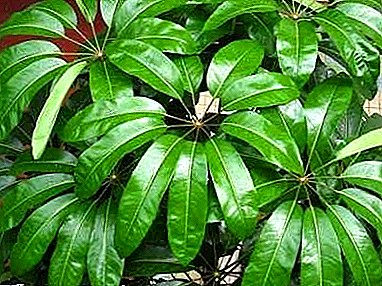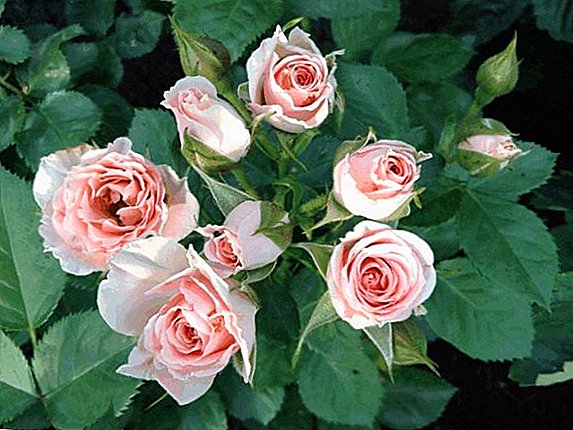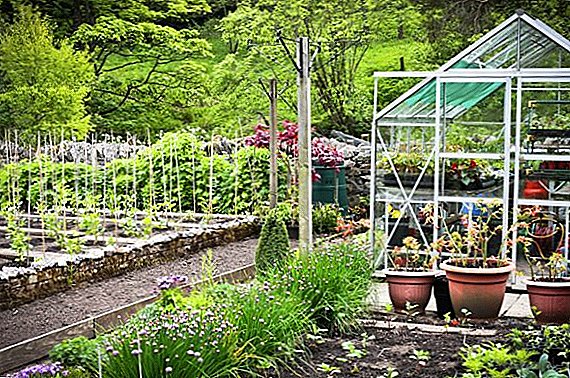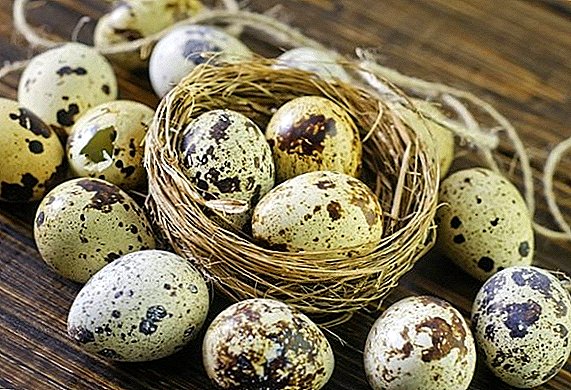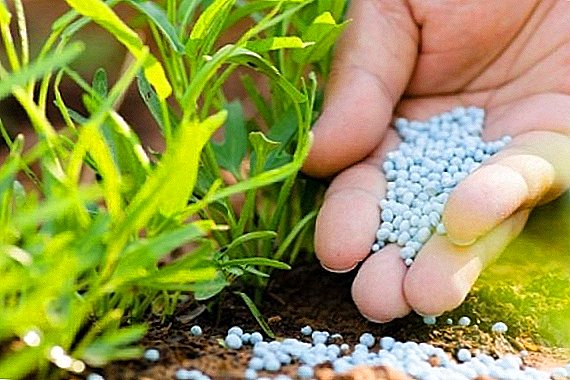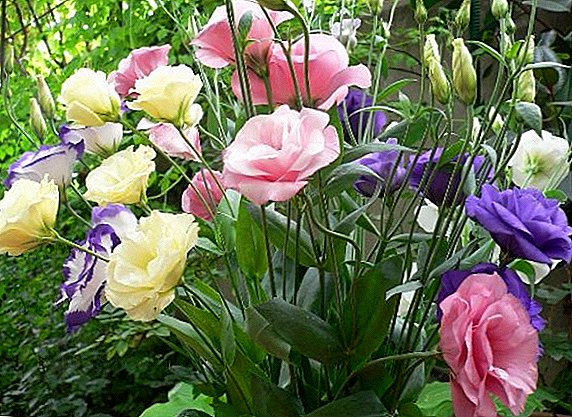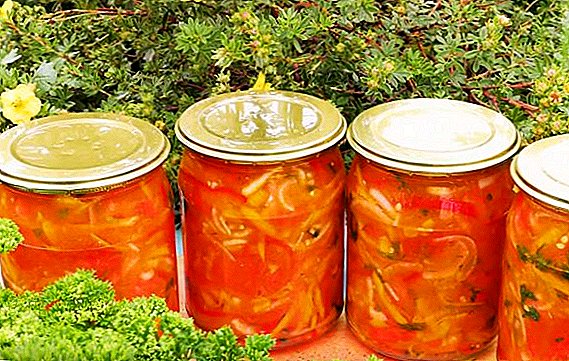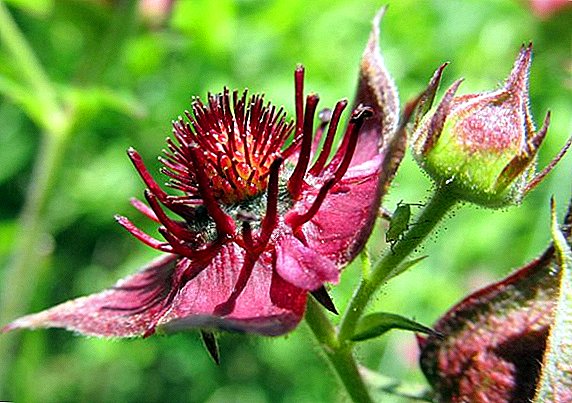 Modern pharmaceuticals are developing with each passing year more and more rapidly, and many modern analogues in the form of tablets, syrups and other drugs from the pharmacy have come to replace folk remedies. But all of them somehow contain extracts of medicinal plants.
Modern pharmaceuticals are developing with each passing year more and more rapidly, and many modern analogues in the form of tablets, syrups and other drugs from the pharmacy have come to replace folk remedies. But all of them somehow contain extracts of medicinal plants.
Today we will talk about the marsh Sabelnik, which is widely used in the treatment of many diseases. We will tell where this plant can be found, how to properly collect it, under what diseases a sabel can be used and what storage conditions it needs.
Sabelnik marsh
This medicinal plant belongs to the family of Pink, looks like a low shrub, no higher than one meter in height. A sabelnik can "crawl" on the ground, since the peculiarities of its structure allow it to stretch both upwards and grow parallel to the soil.
The plant grows well - its stem has many branches that come off from the ground to half a meter in height. The color of the stem is predominantly saturated brick shade, or, as it is also called, red-brown.
The sabelnik leaves are oblong, elongated and with jagged edges. Interestingly, the color of the leaves depends on their location: those that are closer to the sun's rays, that is, higher, are colored green, but leaves close to the soil are radically different and have a reddish color. The reverse, seamy side, all the leaves close to gray. 
Did you know? Sabelnik marsh has many popular denominations. Often called a plant "five-leaf clover", "decode", "cinquefoil marsh", "fireflower ordinary", "raven sabelnik", "wolf body" or "wild raspberries". The most commonly named plant "marsh rose" because of its flowers or "Russian ginseng".We should also talk about the rhizome of the chenbella It is quite long, strong, and branched as well as the stem. At times, the root of a plant can stretch in a few meters, but often these branches are intertwined. Characteristically, its rhizome does not interfere with the growth of other plants.
It is possible to see how the sabelnik blossoms in the first two summer months. Flowers have an average size, their color, as a rule, is rich crimson. In shape, these flowers resemble an asterisk, since each flower has five petals. Sabelnik flowers are characterized by belonging to both sexes, as well as by the presence of an undermaw, which consists of five leaflets.
In the last summer month, fruits are formed, forming from the so-called nuts (they are also called bare seeds).
The name of the plant directly indicates the locality in which the sabelnik is most likely to meet. First of all, these are places with high soil moisture - the banks of rivers, lakes, and other water bodies.
Geographic location also plays a significant role, because the sabelnik prefers areas with a temperate climate, but in the northern regions of the country it’s quite problematic to see this plant with your own eyes.
Sabelnik can be grown on your site, using it in the decoration of the pond.
Collection and storage
In order to fully feel the healing power of the plant, you should follow certain rules, in particular, what part of the plant should be used, what time of year it should be collected and what to do to save the raw material.
As for the marsh rose, it has all the healing parts, the only difference is in the method of drying and the date of collection. So, for the rhizome of the cagel is best to go in March or November. You should not wait until the end of March to cut off the root, because at the time of flowering all the nutrients and trace elements enter the leaves, which is why the root becomes less useful.
In November, wait for the moment when all the leaves die off, then the vital juices will return again to the root system of the marsh rose and this part of the plant will become the most useful.
Important! When collecting rhizomes, it is necessary to choose parts younger, since only they have healing power. Pay attention to the color of young roots: their outer part is brown in color, and the inside is green. As a rule, their length is up to 50 cm.Older roots are characterized by black color, it is pointless to use them for treatment - they do not contain beneficial substances.
 After you cut the required amount of root system, they need to be processed. First of all, the roots are thoroughly washed with water from the tap, after which they need to be cut into sticks, no longer than 3 cm. Only after that you can start drying the sabelnik.
After you cut the required amount of root system, they need to be processed. First of all, the roots are thoroughly washed with water from the tap, after which they need to be cut into sticks, no longer than 3 cm. Only after that you can start drying the sabelnik.We advise you to do this on sunny days, since the prepared raw materials must be placed on the board so that the rays of the sun fall on it. It is important that the place where the sticks are dried is aired.
After a few days, check how well the sabelnik has dried. To do this, the stick must be broken. If it breaks down with a characteristic crash, then everything is in order and the roots can be removed. But bending sticks - a sign of insufficient drying.
Also, you can use the oven to dry the sabelnik - you can either complete the drying procedure or carry out it completely if you have collected the material in the fall and it is difficult to wait for the sun to get wet.
Important! In this case, observe the only rule: the temperature inside the oven should not exceed +40 ° C.As for the other useful part of the plant - shoots - then you need to come after them just in summer, because at this time of year this part develops as actively as possible, which means that nutrients circulate through it.
 It is necessary to cut off the upper part and not to approach the soil, because there the humidity is too high, which means that the shoot can rot. Choose parts exclusively green, blooming.
It is necessary to cut off the upper part and not to approach the soil, because there the humidity is too high, which means that the shoot can rot. Choose parts exclusively green, blooming.Drying shoots has its own characteristics. Placing them under ultraviolet light is not required. It will be sufficient to place the raw material on wooden sheets or in shallow containers so that it can dry. Ideal would be a ventilated place, as well as protected from sunlight. Shoots periodically need to stir up, so as not to begin the process of decay.
There are enough ways to store both roots and shoots so that you can choose the most suitable option for you. Glass jars and linen bags will also do; do not neglect paper bags either. The shelf life of Russian ginseng is three years. It is not worth saving raw materials longer - its useful properties will be lost.
Learn how to properly harvest and store thyme, lime blossom, calendula, currant leaves, dog rose, cherry leaves, mint, raspberry leaves, hawthorn, willow-tea.
The rich
Of course, the medicinal use of the plant was found because of the content of useful substances in it. Marsh rose is rich in essential oils, organic acids, as well as tannins. The latter have anti-inflammatory properties, as well as help to stop the blood in case of bleeding.  With the help of anthocyanins, you can easily restore vision or improve the quality of the eyes, and thanks to catechins, which are also part of Russian ginseng, you can improve your metabolism. To remove the tumor helps in the plant saponins.
With the help of anthocyanins, you can easily restore vision or improve the quality of the eyes, and thanks to catechins, which are also part of Russian ginseng, you can improve your metabolism. To remove the tumor helps in the plant saponins.
Sabelnik has flavonoids that help strengthen blood vessels, as well as ascorbic acid, which has a beneficial effect on the body's ability to defend against viruses.
Did you know? Surprisingly, drinks and ointments prepared on the basis of the marsh rose are rich in phosphorus and calcium, which means they strengthen the bone tissue.The bitterness of ginseng suggests that the plant can be used as a natural diuretic or laxative. The magnesium content has a beneficial effect on the cardiovascular system.
Caramel Recipes
The collection and procurement of raw materials is undoubtedly an important stage, but this is only the beginning. To feel the healing powers of the plant, you need to learn how to apply it correctly. We present to your attention several ways of preparing tinctures and decoctions from the roots, which are used more often, as well as from leaflets. 
Alcohol tincture of cinnamon roots
In the preparation of tincture of marsh rose nothing complicated. You only need the roots, as well as vodka.
The sabelnik sticks need to be broken down into three parts so that you can have blanks no longer than 10 mm long, put them in a glass container with a tight-fitting lid so that the raw materials take up the third part of the container, then add vodka to the vessel - it will take about 500 ml .
Important! It is advisable to use as a vessel a 1 liter jar. A spirit drink should have a strength not lower than 40 °.Hermetically close the container with a lid and put it in a place where the sun's rays do not penetrate. A couple of times a week you can get the tincture to shake its contents, and then return the not yet ready drink to its original place.
The time of infusion of the drink is three weeks, after this period you can take the tincture, observing the following dosage: three times a day before meals you must drink one tablespoon of tincture. We recommend drinking it with water, but not diluting, because the drink contains alcohol.  The tincture is used in the treatment of arthritis, arthrosis, as well as malignant tumors and leukemia. However, due to the alcohol content, it is contraindicated for those who have problems with the heart, lungs, as well as children and women in the position and breastfeeding.
The tincture is used in the treatment of arthritis, arthrosis, as well as malignant tumors and leukemia. However, due to the alcohol content, it is contraindicated for those who have problems with the heart, lungs, as well as children and women in the position and breastfeeding.
With arthritis, the gentian, veronica officinalis, echinacea, crassula, marigolds, burdock leaves, aspen, Indian onion, wild rosemary, creeping couch grass, bay leaf, mordovnik, willow, enoteru, adam root, star spruce, lilac, yucca, trencher help.
Alcohol tincture of roots and leaves of sabelnik
As we said earlier, not only the root system, but also the leaves have benefits in a sabelnik. In this recipe, we need both of these ingredients, as well as vodka.
Raw materials (in the amount as in the previous recipe) should be finely chopped, poured into a 1 liter jar, after which alcohol is added (0.5 l), in our case it is vodka. Next we use the capron capron - it will allow the tincture to "breathe", but at the same time protects the contents from the external environment.
Leave the drink for three weeks in a protected place, after which you can consume it three times a day in the amount of one tablespoon. Do not forget about contraindications, since alcohol is present in this recipe.
Decoction of the roots of sabelnik
To prepare the broth, you will need no more than a tablespoon of sabelnik roots (already dried) and 250 ml of boiling water. After you fill the raw water with water, leave the drink for 60 minutes, then strain with gauze. 
Important! Between taking the decoction of Russian ginseng and directly breakfast, lunch or dinner should pass at least an hour.You can safely drink this broth, but do not forget about the dosage: 50 ml of broth before each meal, but not more than four times a day.
Coon's Ointment
Preparation of ointment will take more time than decoction and tincture. This is due to the fact that some ingredients must be prepared to include them in the composition of the ointment.
Red pepper needs such preparation, because tincture is taken from it for ointment. Preparing such a tincture is simple, with the help of hot red pepper (not Bulgarian) and vodka.
Place the vegetable in a container, add 200-250 ml of vodka there, and then leave the container for 1.5 weeks in a dry place protected from sunlight. One teaspoon of this infusion will be enough for ointment.
Shortly before starting the preparation of the ointment, make an infusion of marsh rose - for the ointment you will need no more than one tablespoon. Stock up with lanolin cream, vitamin E (you can find it in pharmacy items) in the amount of three drops and a tablespoon of honey.  Mix the ingredients in the specified amount until smooth, and then transfer the ointment to a glass jar or other container with a lid. We recommend keeping the Russian ginseng ointment in the fridge. Very well, such an ointment helps in the treatment of diseased joints.
Mix the ingredients in the specified amount until smooth, and then transfer the ointment to a glass jar or other container with a lid. We recommend keeping the Russian ginseng ointment in the fridge. Very well, such an ointment helps in the treatment of diseased joints.
Poultice for fresh leaf wounds
Russian ginseng has anti-inflammatory properties, which is why it can act as a natural antiseptic. Especially this property will be useful during outdoor recreation - you just need to attach a leaf to the place of injury. It will stop the blood and reduce the risk of infection through the wound.
The healing effect of Kalanchoe Degremona, clove oil, lovage, beeswax, burdock root, mint, sloe, sedge, thuja, silver fox, primrose, plantain, ivy, goose onions, nettle, propolis ointment, turmeric, aloe, poviliku.At home, you can use harvested, dried leaves. They need to be "warmed up" with boiling water - place the raw material for a short time in a container with hot water, then place the leaves in a bandage and only then apply it to the sore wound. You cannot neglect the bandage or gauze - you can get burned.
Indications for use
Russian ginseng is a healing plant, so it can be taken both for prevention and for treatment. Tinctures and decoctions of crab are used in a number of different diseases, so familiarize yourself with all the areas where this plant can be useful. 
Important! Please note that the treatment with marsh rose has its own characteristics. One of the most important is the exacerbation of the disease, since the plant initially does not have a sedative or painkiller actions . Therefore, be prepared for the fact that at first your disease will be exacerbated by the sabrelnik, and only after that the long-awaited relief can come.
Diseases of the cardiovascular system
When diseases of this type are used, as a rule, tinctures and decoctions based on the medicinal plant. Sabelnik helps to reduce pressure, which is why it is not recommended for hypotensive.
Treatment of pathologies of the osteo-articular system
It is good to use the plant for back problems - the symptoms of osteochondrosis, gout or radiculitis are excellent for taking homemade preparations.  The arsenal of treatment of bones and joints includes both decoctions, tinctures or compresses based on this beautiful plant, as well as ointments.
The arsenal of treatment of bones and joints includes both decoctions, tinctures or compresses based on this beautiful plant, as well as ointments.
Diseases of the digestive system
Also, decoctions will be useful for people with chronic diseases of the gastrointestinal tract, as well as after intoxication of the body. Such an unpleasant condition as diarrhea, it will eliminate the decoction or tincture without alcohol.
In diseases of the gastrointestinal tract should pay attention to calendula, cinquefoil white, Kalanchoe, aloe, salvia, propolis, sage, sweet potato, bluebud, white mar, anemone, spurge.
Respiratory diseases
Sabelnik marsh perfectly copes with colds, including angina, bronchitis, pharyngitis, laryngitis and other diseases of the respiratory organs. In such cases, you can use a decoction based on the plant, it is best to use it as a means for rinsing. It will relieve inflammation from the throat and relieve your condition. 
Rheumatic diseases
If you suffer from arthritis, arthrosis, inflammation in the joints, rheumatic lesions of bone tissue, then this wonderful plant will come to your rescue.
All this is treated with the help of various tools based on Russian ginseng, from tinctures to ointments.
Infectious diseases
In the treatment of infectious diseases, cinnamon will help your body fight with the influence of pathogenic bacteria and microbes.
Gynecological diseases
In this area, more often used external means, in our case - it is an ointment or compress based on the marsh rose.
For gynecological diseases, yarrow, bathing, Kalanchoe pinotum, white acacia, royal jelly, chamomile, cloves, hops are used.
Uterine bleeding, colpitis, adnexitis and other unpleasant diseases of the female genital organs, if they do not disappear for good, then they stop tormenting the body with painful symptoms after applying the sabelnik ointment. 
Contraindications
Whatever the benefits of a marsh rose to the body, it does not do without contraindications. It is strictly forbidden to resort to the help of sabelnik to people suffering from low blood pressure. Another contraindication was slow heartbeat (bradycardia).
Important! Be sure to consult your doctor before you start taking medicines based on this herb!Do not use products containing this plant if you are allergic to it or are highly sensitive to its components.
Alcohol-based tinctures are not recommended for use in the treatment of people addicted to alcohol, children, pregnant and lactating women.
Sabelnik marsh - a wonderful medicinal plant that will help to recover from many ailments. Однако следует помнить о его противопоказаниях и не переусердствовать с дозировкой.



